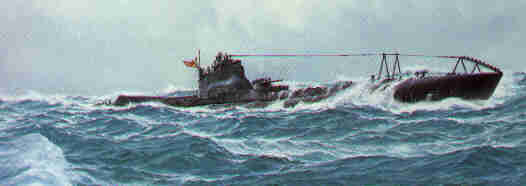SENSUIKAN!

IJN Submarine I-46: Tabular Record of
Movement
© 2001-2018 Bob Hackett & Sander Kingsepp
Revision 1
21 November 1942:
Laid down at Sasebo Navy Yard as
Submarine No. 376, the lead boat of the
C2 subtype.
25 May 1943:
Numbered I-46.
3 June 1943:
Launched and provisionally attached to Yokosuka Naval
District.
23 December 1943:
LtCdr (Cdr, posthumously) Yamaguchi Kozaburo
(59)(former CO of I-176) is appointed the ad hoc Chief Equipping Officer
(CEO).
1 February 1944:
LtCdr Yamaguchi is reassigned as the CEO of I-46.
29 February 1944:
I-46 is completed, commissioned in the IJN and
attached to Yokosuka Naval District. Assigned to SubRon 11 for working-up.
LtCdr Yamaguchi Kozaburo is the Commanding Officer.
2 April 1944:
Off Minase Bight, Iyo Sea. During a training
sortie, I-46 collides underwater with RO-46 and suffers damage to her
conning tower and periscopes.
3 April 1944:
At 0430, USN codebreakers intercept and decrypt a
message that reads:
"1. While this unit was carrying out picket patrol duty
2 April, I-46 and RO-46 had underwater collision at 2145, --- distance to
southwest of Kominasa Light. 2. Damage summary: I-46, 2 periscopes damaged.
Part of --- slightly damaged. RO-46 --- (blanks) --- diving (planes?)
damaged. (Expect docking will be necessary)."
7 May 1944:
After initial testing returns to Sasebo Navy Yard for
repairs.
30 May 1944:
Reassigned to SubDiv 15, Sixth Fleet (Submarines).
12 August 1944:
LtCdr Yamaguchi submits a memo to the Sixth Fleet
HQ and ComSubRon 11, suggesting improvements related to the Type 13 air-search
radar installation and the application of the anti-radar coating. [1]
13 October 1944: Operation "SHO-1-GO" - The Defense of the
Philippines:
Tokyo. Admiral Toyoda Soemu, CinC, Combined Fleet, orders the
"Sho-1-Go" plan activated.
19 October 1944:
Departs Kure on her first war patrol to take up
station 120 miles E of Leyte, Philippines with the "B" Group. Her assigned
sector is the westernmost one, next to that assigned to I-54.
20 October 1944: American Operation "King Two" - The Invasion of Leyte:
Admiral (later Fleet Admiral) William F. Halsey's (former CO of SARATOGA,
CV-3) Third Fleet of 738 ships including 18 aircraft carriers, six battleships,
17 cruisers, 64 destroyers and over 600 support ships land the Army's X Corps
(24th Infantry and 1st Cavalry Divisions) and the XXIV Corps (7th, 77th and 96th
Infantry Divisions) that begins the campaign to retake Leyte.
24 October 1944:
Vice Admiral Miwa Shigeyoshi, Commander, Sixth Fleet
orders I-46 and ten other submarines to converge in an area from Samar to
Surigao Strait, Philippines.
25 October 1944:
E of Leyte. Around 0645, I-46 is forced to dive by
a patrol aircraft and chased by an enemy vessel identified by her propeller
noises as a destroyer for the next eleven hours. Over 200 distant depth charge
explosions are recorded during that time.
26 October 1944:
LtCdr Yamaguchi reports sighting a small enemy
convoy to the E of his assigned station. It is the last signal received from
I-46.
27 October 1944:
Headquarters, Sixth Fleet orders I-46 to proceed to
a new station to the E of Leyte, but the signal is not acknowledged by LtCdr
Yamaguchi.
28 October 1944:
E of Leyte. Cdr Selby K. Santmyers' USS HELM
(DD-388) is part of the screen of Rear Ralph E. Admiral Davison's carrier Task
Group 38.4 (USS ENTERPRISE (CV-6), FRANKLIN (CV-13), BELLEAU WOOD (CVL-24) and
SAN JACINTO (CVL-30), providing direct support to ground operations on Leyte.
At 1218, HELM and Cdr Philip D. Quirk's USS GRIDLEY (DD-380) detect a
submarine trying to penetrate TG 38.4's screen. As Davison's carriers clear the
area at high speed, the two destroyers carry out depth charge attacks. HELM's
4th attack at 1411 brings a heavy explosion, followed by two smaller ones with
oil and air bubbles rising to the surface. GRIDLEY makes three depth charge
attacks.
Their target, either I-46 or I-54 is sunk at 10-58N, 127-13E. Splintered
deck planking and human remains are recovered after the attack. [2]
30 October 1944:
At 1900 (JST), all IJN submarines stationed E of
Leyte report their respective locations to Sixth Fleet HQ. I-46, I-26 and
I-54 fail to answer.
1 November 1944:
At 1900 (JST), I-46, I-26 and I-54 fail to
report for the second time.
2 December 1944:
Presumed lost with all 112 hands E of the
Philippines.
10 March 1945:
Removed from the Navy List.
Authors' Notes:
[1] In all likelihood Type 22 surface-search radar was
likewise installed by that time.
[2] Both I-46 and I-54 have been identified as the submarine lost in
the 28 October attack. Orita and Harrington (1976) suggest that I-46 was sunk
by [LAWRENCE C.] TAYLOR, evidently confusing her with I-41.
Special thanks for help in preparing this TROM go to Dr. Higuchi
Tatsuhiro of Japan. – Bob Hackett and Sander Kingsepp.
Thanks also go to John Whitman of the USA for info on CNO intercepts of
Japanese messages.
Back to Submarine
Page





